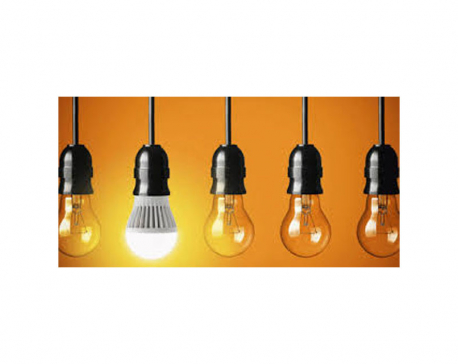
OR
'No power cuts in Valley, some cities this winter'
Published On: November 23, 2017 08:20 AM NPT By: Rudra Pangeni | @rudrapang

'Change in consumer behavior and increase in LED use made power demand stable'
KATHMANDU, Nov 23: Just like last year, there won't be any power cuts in Kathmandu and some other cities this winter, NEA officials said.
The supply this year will be at least at the same level as last year in Kathmandu and a few other cities which were declared 'no power cut' zones.
"Though our efforts to increase supply have almost failed, during the upcoming dry months we will be able to supply electricity as last year, thanks to demand-side management and leakage control," NEA's spokesperson Prabal Adhikari told Republica on Tuesday.
NEA's plan to produce 25 MW electricity from solar plants, import additional electricity from India and save electricity through supply of energy-efficient LED bulbs have almost failed.
NEA has however achieved success to some extent in demand-side management, which has put it in a comfortable position for supplying electricity as last year.
Evening peak load demand on Monday was 1248 MW, just 8 MW more than the same day last year. This shows the peak demand has nearly stabilized and this is at variance with annual average demand growth rate of 10 percent.
Managing evening peak load demand is taken as the most challenging task but this has at least been resolved for the time being, and NEA officials attribute four factors to this achievement.
"Behavioral changes in electricity consumption, consumers who voluntarily switched to more efficient LED bulbs, zero or very little use of inverters and inefficient equipment, and leakage control are the reasons that helped in reducing the peak-hour demand," said Adhikari. Evening peak hours and morning peak hours in this season are 5:30 pm to 7:30 pm and 6:30 am to 8:30 am respectively.
"Consumers have listened to our pleas not to use appliances that consume a lot of electricity during evening and morning peak hours and they also switched to energy-efficient LED bulbs," said Adhikari.
"We estimate that the use of LED bulbs alone has saved around 100 MW," said Adhikari.
NEA officials are also thankful to consumers who have refrained from using high energy consuming appliances like water pumps and heaters during peak hours. NEA's solar plants plan failed after the then parliament's Public Accounts Committee ordered a retender for the solar plants contracts over allegations of corruption in the selection of contractors. Likewise, NEA two months ago had to terminate the contract awarded to a Chinese contractor for building the Dhalkebar substation, which could be instrumental to bring more energy from India. Nepal currently generates 676 MW of electricity while 272 MW is imported from India, so the power deficit stands at around 300 MW.
You May Like This

NEA to discontinue power supply to some areas of Kathmandu valley
KATHMANDU, July 28: Residents of Kathmandu who have been enjoying uninterrupted power supply since some months will face power outages... Read More...

Ktm Valley factories mull expansion on low power cuts
KATHMANDU, Nov 22: Uninterrupted power supply in the Kathmandu Valley since past couple of weeks has boosted the confidence of industrialists... Read More...

Valley likely to suffer power cuts from December
KATHMANDU, Nov 8: The power outage is likely to continue as there is less supply of electricity than demand despite some... Read More...




Just In
- Kushal Dixit selected for London Marathon
- Nepal faces Hong Kong today for ACC Emerging Teams Asia Cup
- 286 new industries registered in Nepal in first nine months of current FY, attracting Rs 165 billion investment
- UML's National Convention Representatives Council meeting today
- Gandaki Province CM assigns ministerial portfolios to Hari Bahadur Chuman and Deepak Manange
- 352 climbers obtain permits to ascend Mount Everest this season
- 16 candidates shortlisted for CEO position at Nepal Tourism Board
- WB to take financial management lead for proposed Upper Arun Project






_20220508065243.jpg)








Leave A Comment